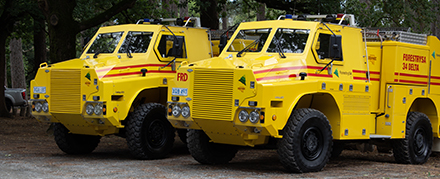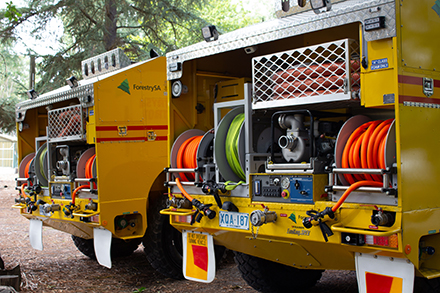Major upgrades to specialist firefighting equipment will underpin ForestrySA’s commitment to community fire prevention, preparedness and response in the Adelaide Hills for many years to come. Source: Timberbiz
ForestrySA’s state-of-the-art FireKing fire tankers have undergone complete refurbishment after almost 20 years on the frontline protecting South Australian forests and communities.
The custom-built fleet was commissioned back in 2005 to meet the niche requirements of forest-firefighting.
Built on the same tough chassis as the Australian Army’s Bushmaster vehicles most recently deployed to the war in Ukraine, the appliances provide unrivalled crew protection and frontline fire access in plantations and steep terrain.
The reinforced, V-shaped hull was originally designed to protect passengers from explosions and landmines. It enables a lower centre of gravity for the FireKing’s on board water tanks and safer crew transport.
Up to four fire crew members can be seated inside the cabin.
It carries 3700L of water: 3000L for firefighting and 700L reserve for crew safety via the vehicle sprinkler system.
Several hundred metres of canvas fire hose, allowing water to be pumped deep into the forest.
All hose fittings now connect seamlessly with CFS tankers and firefighting appliances.
It is powered by a 330 horsepower CAT turbo diesel engine and automatic 6-speed transmission, with 4WD independent suspension and disc brakes, ensuring vehicle capability in the most adverse of conditions.
Heat protective window coverings and vehicle sprinkler system allow the vehicle to withstand temperatures up to 1000°C, protecting crews in the event of a burn-over.
Overhauled electrics to modernise on board operating systems. LED lighting upgrades to improve crew safety during night operations.
ForestrySA Chief Executive Julian Speed said the rebuild was an integral part of ForestrySA’s broadscale commitment to community bushfire protection.
“As the South Australian Government’s forest manager for almost 150 years, we take our role in regional fire protection very seriously”, he said.
“We dedicate far more resources, time and effort than required just to protect our own commercial assets. At ForestrySA, we feel a responsibility to go above and beyond for the sake of our neighbours and our regional communities.
“Our newly fitted-out FireKings are now expected to provide at least 20 years of additional service. We have also worked proactively to provide five new 215,000L community water tanks across the Mounty Lofty Ranges, appliance upgrades for better compatibility with Country Fire Service (CFS) systems, and ongoing access to airstrips and storage facilities to support CFS operations.”
Mr Speed said ForestrySA’s long and at times devastating firefighting history had shaped current day decision-making.
“The tragedy of eight lives lost in the 1958 Wandilo forest fire, the devastation and destruction of the Ash Wednesday bushfires 40 years ago and more recently, at Cudlee Creek in 2019, will never be forgotten,” he said.
“These events are poignant lessons in resilience, innovation and forest firefighting, and have led to major improvements in fire equipment, training, communication, inter-agency cooperation and safety benchmarks.”
Mr Speed said lessons from modern day fire events, including findings from a review of the 2019-20 fire danger season in South Australia, had led to further change.
“We have further strengthened our collaboration with the CFS, aiming to offer specific plantation forestry firefighting expertise through increased involvement in Incident Management Teams,” he said.
CFS Chief Officer Brett Loughlin said ForestrySA’s contribution as a registered CFS fire brigade was invaluable to the state’s fire protection efforts.
“The strong history of collaboration and mutual respect among our brigades and emergency service agencies means we are working efficiently towards the same goal – community safety and protection,” he said.








